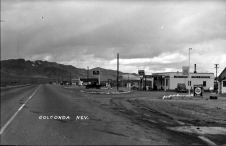McGill
Soon after large copper deposits were discovered in central White Pine County between 1900 and 1902, four towns were established by the companies who owned claims in the area. Of those "company towns," McGill was the largest and most important because it processed ore in a district that would continue to produce copper for over seventy years.
The town was named after nearby ranch owner William N. McGill, whose land was purchased by the Nevada Consolidated Copper Company for the site of its processing plant. McGill's ranch was selected because of its water rights, with Duck Creek and other springs providing a reliable supply.
In addition to the processing plant, over 140 miles of railway were built to form the Nevada Northern Railway, which would connect McGill to nearby mines, as well as to the Southern Pacific Railroad in the northeast corner of the state. A water pipeline, some nine miles long, was also built to bring water from Duck Creek to the site. With water and rail in place, the company began mining operations. By 1908, the first load of copper had been processed and shipped to the east coast. In 1910, McGill was by far the largest town in White Pine County. Over the next twelve years, McGill processed a staggering $166,767,581 worth of ore, with demand brought on largely by the emergence of the electric and telephone industries.
As a "company town," Nevada Consolidated Copper provided housing to employees. At first, houses were built only for top-level supervisors in a neighborhood that would come to be known as "The Circle." Eventually, permanent houses were established for all mine workers and their families. The company, later known as Kennecott, maintained ownership of the houses until 1955 when it sold them to another firm.
The company also provided recreational opportunities for its citizens, including equipment and facilities for baseball and tennis. A clubhouse was built in 1915 that included a basketball court, billiard table, bowling alley, indoor pool, and library. In 1930, an outdoor pool and beach were developed using spring water and white sand from mine tailings.
The community in McGill had a diverse ethnic population, and it was highly segregated at the housing level. Three communities—Austrian Town, "Jap Town," and Greek Town—formed adjacent to, or just outside of McGill. The body of the town was made up of natural citizens, but even it was divided along social classes. Lower Town on the west side and Upper Town to the southeast were designated for lower-income families. Middle Town, in the center of McGill, was for white-collar workers and craftsmen.
The community continued to prosper until the 1970s. With ore supplies dwindling, the company's profit margins became slim. Also, the Environmental Protection Agency (EPA) had taken notice of the poor air quality in McGill. The company would go so far as to build a 750-foot smelter stack to replace two smaller ones in an effort to reduce the smell of sulfur dioxide and satisfy the EPA. The new chimney was accompanied by a computer system that tracked environmental data, allowing operators to slow production if the air quality approached state or federal limitations. But in the end, the company could not bear pressures from foreign competition combined with diminishing ore supplies and EPA regulations. In 1983, Kennecott ceased mining operations in McGill.
Despite losing the core industry that for so long had nourished its citizens, McGill survived. In 1987, the Nevada Northern Railway became an attraction by reviving its historic route between Ruth and McGill. Later that year, the Great Basin National Park was established on Nevada's eastern edge, which helped bring tourists to the region. In 1989, a maximum security prison was built in nearby Ely, which brought jobs to McGill. In 2000, the population stood at 1064, about half of what it was in 1910.


